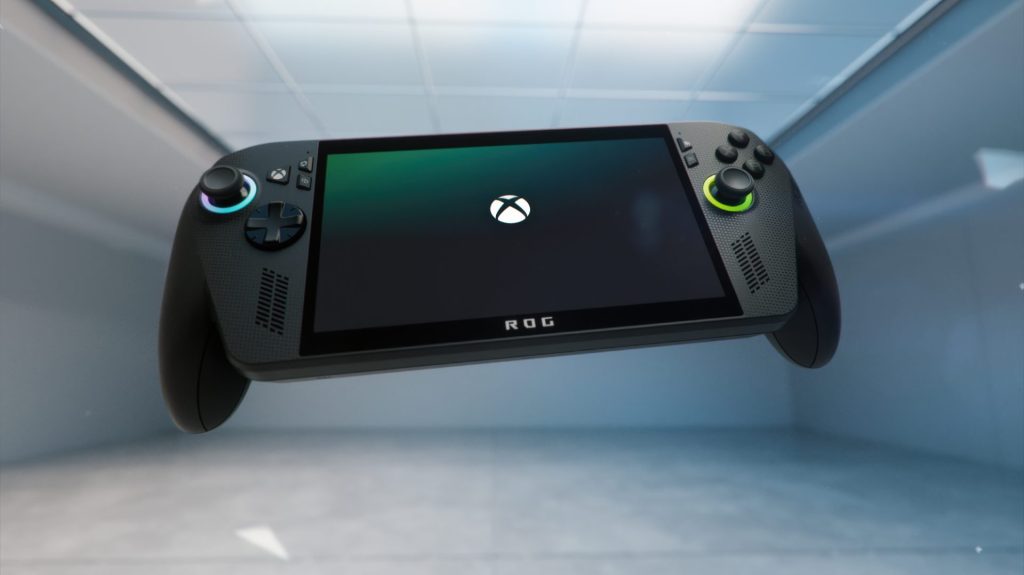Between Valve’s Steam Deck OLED, Lenovo’s Legion Go, last year’s ROG Ally X, and ASUS’s new ROG Xbox Ally, and the Switch 2, the handheld market is abuse with excitement. The top of that heap, the ROG Xbox Ally X, has held gamers’ gaze since its reveal, but perhaps for the wrong reasons, price being one of them. I’ve spent dozens upon dozens of hours with this glorified Asus handheld in an Xbox skin and there’s more to dig into than meets the price-seared eye. So, let’s see if this $1000 handheld is really worth overlooking the other cheaper options, shall we?
How It Stacks up to Competitors

First, I found it helpful to think of the Xbox ROG Ally X as an Xbox themed expansion pack to last year’s ROG Ally X. It’s a substantial expansion, but it’s not quite a new sequel altogether. Considering the sheer power of yesteryear’s Ally X, that’s nothing to laugh about; in fact, it marks it as the most powerful handheld console on the market. With AMD’s latest Ryzen Z2 Extreme chip, faster 24GB memory, and an AI-ready NPU, it delivers up to 30% better performance while running cooler and longer on the same battery as last year’s model. It’s also generally more efficient and powerful than the Steam Deck OLED and Legion Go. Though, display buffs will no doubt enjoy the larger refined screen the Legion Go provides over the Xbox Ally X’s 7 inch FHD one. The 1080p 120Hz display is kept remarkable glare-free throughout my entire time with it, which I appreciate.
It’s the ergonomics and … Xboxiness of it that provide that special sauce for me. The impulse triggers, enhanced haptics, and textured grips are some of the most enjoyable and durable I’ve felt. I’m reminded of the old Duke controller, that’s how darn good this feels. You can’t get that with the Steam Deck or Legion Go. On the software side, it boots into a console-inspired Xbox interface while retaining full Windows 11 flexibility.
Ergonomics
Enough about comparisons though, once you get your hands on the joysticks of this thing, you can’t help but want to game for hours. There’s some high quality rubber with some tough textured grip around the sides of the sticks, giving it a premium feel. Gliding the sticks feels silky smooth and clicking them in feels like second-nature if you’re an Xbox player.
Regarding the grip and contour, I occasionally get some palm fatigue from the wide handle-grasping after long sessions. But overall, the lightweight design and smooth contours make it easy to hold for hours. The upside to the large handles is the grip. The texture and contour of the handles securely locks the console in place, and I never had the thought that it might slip or drop. For such a bulky looking device, it sure is light and secure in the hands.
Build quality is strong with this Xbox-branded Ally X. The rugged, high-grade plastics give it a tough, durable feel that inspires confidence. It’s great not needing to be overly protective when handling the thing. It may be the most expensive handheld on the market, but at least it feels like it can withstand some abuse.
That said, dust does tend to gather around the screen edges and the base of the thumbsticks. And since the joysticks aren’t Hall Effect, there’s no guarantee they’ll remain drift-free over a long stretch of time.
Oh, and you’ll be smearing dust on it quite often considering the display doubles as a touch screen. The d-pad is so close to the screen that it’s incredibly easy to accidentally tap or swipe it, causing interface and control swapping to occur. I’ve lost count of how many times I’ve miss-clicked or interrupted navigation because of the low d-pad proximity with the screen.
Another small thing to note are the sound of the clicks and presses. The face buttons on this are noticeably louder than on PlayStation or Nintendo controllers, with the D-pad producing a crunchy click that’ll grab attention in quiet environments. The triggers, however, are the opposite, responding with soft clicks and dead silent presses from the shoulder buttons. In short, this is the latest in the line of Xbox controllers. It’s got that nostalgic Xbox feel and contour with a premium touch.
Setup and Onboarding

It’s also got some of the classic Xbox flair with its presentation. I was greeted with a sleek activation animation when booting it up, and I admit that I smiled when the RGB lighting illuminated both thumbsticks (easily customizable, by the way). Since I’m not much of a QR code instructions reader, I just winged it and jumped in without much tutorializing. If it’s your first time using a hybrid Windows gaming handheld, you’ll be met with some confusion, especially since the onboarding process is very light.
All your updates and controller mappings are handled through Windows 11 or Armoury Crate, ASUS’s built-in interface for all things ROG Ally. It’s easy to jump between apps and game launchers — just press the Xbox button or use the cursor to minimize like you would on any PC. The hybrid Windows/Xbox setup makes control customization simple, with both console and desktop modes fully mappable through Armoury Crate.
That said, I wish switching between the two modes could be done with a single button instead of diving into the game bar overlay each time. Still, you can set one of the sticks to act as a mouse or use the touchscreen to navigate Windows, then flip back to console mode when you’re ready to game.
The on-screen keyboard is large enough for most hands, but an external keyboard is definitely better if you plan to do a lot of typing. For casual users or kids, the fundamental controls are pretty straightforward: the Xbox menu button alone can handle most app swapping. But for some, the hybrid control scheme might feel confusing and unintuitive.
Performance With Game Tests
I stress tested the Xbox Rog with six beefy games. Forza Motorsport, Microsoft Flight Sim 24, Gears Reloaded, GTA 5, Resident Evil 2 Remake, and the oft-maligned Ghost Recon Breakpoint were my guinea pigs and they suited the task admirably. Among all six, Forza Motorsport struggled the most to both look and feel spectacular, but none of them failed to perform well. During my time testing Forza Motorsport, I was able to push the framerate to 60 and beyond, but only by sacrificing visual elements like detailed window reflections, track fidelity, or car detail. Running it on a balanced high setting delivers smooth performance as long as the Ally X is set to Performance or Turbo mode. If you prefer a quieter, fanless experience, you’ll have to give up the kind of visual fidelity and framerate that makes these racing sims pop. That trade-off applies to most games I tested, but it was most noticeable in Forza.
Resident Evil 2 and GTA 5, on the other hand, are so well optimized that I rarely saw frame dips or stutter, even on very high settings. And unlike racing titles, the occasional inconsistency in detail doesn’t stand out as much — after all, ultra-detailed cars racing across flat, textureless tracks is far more jarring than a zombie missing some extra pores and cuts.
Naturally, cranking everything to max will increase loading a bit, but the Xbox ROG isn’t meant for ultra settings anyway. The $1000 machine contains the most powerful handheld GPU available right now. Even so, the Xbox ROG can handle most modern games smoothly at high settings without major compromises.
Fan noise stays manageable most of the time. You’ll really only notice it in Turbo Mode, where it ramps up under heavy load; not quite helicopter levels, but definitely small leaf-blower levels. I didn’t feel confident running my test games in Silent Mode unless I was okay with lower graphics or fluctuating framerates. For indie or lighter titles, though, Silent Mode is pretty dang ideal.
Battery Life & Heat
The real big drawback playing any handheld device game on high settings is battery life. Even with the top-of-class 80wh battery, you’ll need to charge often when engaged in high performance gameplay. I’ve had the charge go from 90% to 10% in just an hour of Forza Motorsport on high-ish settings. And this with the Turbo setting on in the Armoury Crate, by the way, so the fans are at full capacity.
Thankfully, though, it doesn’t take an unreasonable amount of time to top up a charge. Roughly 50 minutes or so from empty to full, so not bad. But you can easily sneak in 2 hours of of your favorite games with a 30 minute charge so long as you’re playing on medium graphics settings. In everyday use, the Ally X’s endurance depends heavily on what you’re doing. You can expect around 6 hours and 30 minutes of battery life when running light apps or indie games and roughly 2 hours for well-optimized AAA titles.
I’m pleased to say the heat from Ryzen’s new chip is very livable. Even when throttling the system on ultra graphics, the vent areas never got blisteringly hot. Oh, it gets hot, yes, but not uncomfortably so. Silent mode dissipates no heat whatsoever, so if you’re in an already warm climate, that’s the comfortable option for sure. All told, the Xbox ROG is the most quiet, and coolest, gaming device I have besides my Switch 2 and 3DS, and I have a lot of devices.
User Interface
Speaking of graphics modes and cooling fans, all of that and much more is controlled through the device’s dedicated hub named the Armoury Crate. Switching between performance modes is easy breezy: just pull up the Command Center and tap one of the four presets. Users can get as personal as they want with the extensive customization options inside Armoury Crate. Want fan #1 running at 90% speed once the system hits 70°C? No problem — that’s fully adjustable, along with a wide range of other performance and thermal parameters. You also have full control mapping customization across two distinct modes: Gamepad and Desktop.
The system’s hybrid nature between Windows and Xbox interfaces makes this handheld unique, but it’s also where things can get messy. During my time recording footage for this review, I experienced noticeable lag when switching between desktop and console modes. At times, the UI simply wouldn’t recognize the Windows cursor, forcing me to fiddle back and forth until it responded. To be fair, that was mostly while capturing footage, which puts extra strain on the system, but even in normal use, transitions between desktop cursor mode and console mode can occasionally misbehave.
Armoury Crate itself doesn’t support cursor control, which makes its anti-desktop design especially odd — particularly since it’s the very app used to switch control modes. The Xbox button’s quick menu also can’t be navigated with the cursor, which feels unnecessarily restrictive. In short, the hybrid setup works, but it could be a lot smoother and more seamless — especially if you’re multitasking or running other programs.
The in-built recording features are another mixed bag. The built-in recorder doesn’t function properly inside the Armoury Crate app. Recordings and screenshots only function in-game or through the Xbox app. It also refuses to record the home menu, blocking capture entirely.
Speaking of not functioning, I strongly recommend avoiding running two games at once. It completely eats up system resources and occasionally even registers inputs in both games simultaneously. At one point, I accidentally changed the language in Resident Evil 2 while enthusiastically crashing my Civic Type R in Forza. Lesson learned.
A final note on the UI. Both the Xbox and Armoury Crate UIs can be a bit sluggish when waking the system from sleep or booting up, but the lag disappears after about ten seconds. Though, don’t be too suprised if switching between apps lags out input for a tiny bit; it’s happened to me several times.
As for Game Pass, sign-in and game management are fairly straightforward, though offline play can occasionally throw up small quirks or “can’t verify license” pop-ups which override other apps.
I did have a brief moment of terror where I thought the system had completely bricked. It wouldn’t power on, the indicator light was off, and charging did nothing. After some research, I found out this is a known quirk with the high-powered Ryzen chips used in the Rog Ally X, and apparently the enhanced z2 chip inside this $1000 beast does the same. The solution is a series of force restarts that I won’t get into here, but it’s worth addressing that when all the lights go out and nothing works, look up some fixes and you’ll find solutions (unless yours really is bricked).
Controls, Haptics & Audio

I’m getting painful flashbacks of the $1000 handheld not turning on now, so let’s turn to the wonderful world of Xbox controllers, shall we? The Xbox-ified analog sticks offer a generous dead zone range, giving me precise control whether I’m carving corners in Forza or lining up destroying locusts in Gears of War.
The impulse triggers feature integrated haptic motors. They’re not as dynamic or powerful as the DualSense haptics on the PlayStation 5, but they do a perfectly serviceable job of adding tactile feedback that keeps gameplay immersive. If the rumble feels a little too faint out of the box, you can easily tweak the intensity in Armoury Crate. Each controller side even has separate top and bottom vibration zones, though I did notice the right-side vibration is slightly weaker than the left.
But the real standout here is the audio. The built-in speakers are simply phenomenal. The volume range on the Xbox ROG is nothing short of spectacular — easily the most dynamic stereo setup I own, even compared to my smart TV, laptop, and Switch 2. It’s not just about loudness either; there’s real clarity and punch here. The system delivers clean highs, deep lows, and a remarkably high peak threshold for a handheld device.
If you want to play more quietly, there’s a standard headphone jack that outputs equally crisp sound, and Bluetooth pairing with wireless headphones is also supported for those who prefer a cable-free setup. Whether you’re blasting music or playing in bed with headphones, Xbox ROG’s sound profile impresses.
Console Storage
If you’re as much of an audiophile as myself, you’re probably wondering how many video game soundtracks you can install on here. Oh who am I kidding, that storage will just be filled with AAA games. Well, that’s where the Ally X upcharge establishes its value—that beefy 1 terabyte storage. After updating the system and installing Armoury Crate, the Xbox app, and other built-in tools, I had around 830GB of usable space left. With the massive file sizes of modern games, expect room for roughly six to eight AAA titles plus a handful of smaller indie games before space starts running thin.
Thankfully, microSD expansion is simple and painless, though swapping out the internal SSD is a much more involved process that requires a guide and some mechanical confidence.
What’s Included and What’s Not
It’s worth noting that a docking station isn’t included in the box. You’ll need to purchase one separately, preferably through Asus for full compatibility. The good news is that the USB-C and USB4 ports fully support video output, so TV or external monitor setup is doable for those wanting a traditional setup.
So what do you get besides the machine itself? Well, about what you’d expect. The most notable thing is three months free of Game Pass premium, giving newcomers to Xbox’s ecosystem lots to play right away. There’s also a dedicated charger and cardboard stand. Yeah, cardboard. It’s probably the cheapest handheld stand I’ve ever seen and it’s not any more stable than it looks. The charging cable, on the other hand, is solid: durable, thick, and a decent length. Just be aware that the power brick gets quite hot while charging. For $1000 you’re not getting any other accessories like a dock or adaptor, just the charger and the stand, but it’s the thought that matters, right?
Who’s This For Anyway?

But those eyeing this top-of-the-line handheld aren’t demanding a diamond stand. This is for the gamers wanting the best handheld experience on the market today. Game-Pass subscribers who are always on the go have everything they could want with the Xbox Rog Ally X. And Windows PC users also get a level of portability with the precise feel of a console all in one.
I’m not convinced tech infants or younger children will find the hybrid nature all that intuitive, but at such an exorbitant price point, it’s clearly aimed at a more dedicated audience anyway.
Final Value Assessment
The Xbox ROG Ally X delivers top-tier performance with dynamic hybrid portability. It’s like a portable Windows PC and Xbox Series S all in one. It’s not absolute perfection, but the functional execution of such a hybrid concept outweighs the confusing layouts and occasional bugs. Even without the inclusion of accessories for docked play and the like, this all-in-one handheld hybrid console exudes performance and power. For hardcore gamers seeking a portable machine that can handle all the modern AAA titles with the versatility of a Windows PC, the Xbox ROG Ally X stands out as a premium choice worth the investment.



